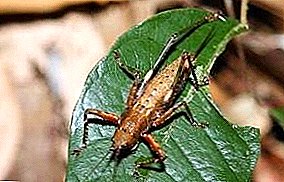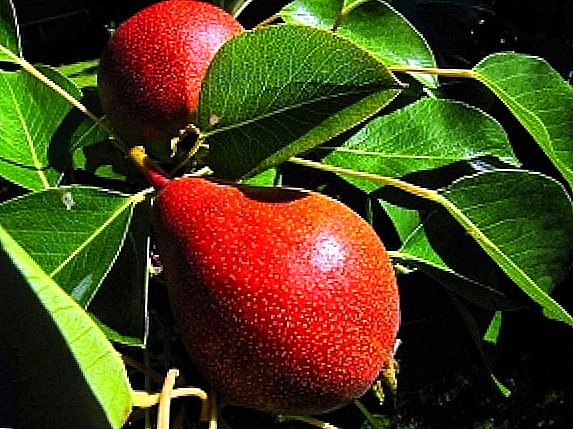
Cicada singing is associated with something beautiful, romantic and summer. However, in real life, not everything is so rosy, and these ringing insects bring a lot of problems to gardeners and farmers.
Few people know that cicada is one of the worst enemies of cultivated plants. There are several varieties of gluttonous "singers", and the neighborhood with each of them can bring significant losses to the au pair.
White
White cicada or metalcaphealso known as citrus cicadas, appeared in Russia quite recently. For the first time it was talked about in 2009, when a massive insect invasion of farm and agricultural land began in the Krasnodar Territory. Her homeland is North America, from where she was brought with infected fruit and seedlings.
What does it look like? This is a small insect greyish white color Body length varies from 7 to 9 millimeters and due to the wings has a drop shape. Externally, it can be compared with a small moth.
White cicada - photo:

Larvae or nymphs of citrus cyclists begin to appear in the second half of may. Sometimes on plants you can see white woolly bloom - this is the larvae. It is the nymphs that bring the main damage to agricultural plants.
What is dangerous? Metal larvae larvae not only suck sap from plants, weakening their immunity and slowing down the process of photosynthesis, but also are carriers of viral diseases. It is worth noting that the insect "diet" includes more than 300 different plant species, ranging from fruit trees and ending with cereals. They are often met on raspberries, cherries, gooseberries, plums, grapes and other cultures.
Buffalo
Buffalo Dicade or cicada - Another kind of cicadas, causing great harm to human gardens. Homeland of this species is North America.
Brokeback brings huge damage vineyards.
How to recognize? It is a miniature insect of green color and a long calf up to 1 centimeter in females and 7-8 millimeters in males. Over his head is located peculiar growth, because of which the cicadas got its name. In case of danger, the roach can fly away from the pursuer.
Buffalo Dicat - photo:

What is dangerous? An adult insect lays eggs on young shoots of grapes. For this, the cicadon cuts its bark with its ovipositor, and lays 6-12 eggs into the resulting cuts. Gradually damaged shoot dies off, and the grown larvae fall to the ground, where they feed on the sap of the nearest plants.
Mountain
It can be found both in the Far East and in the south of Siberia. Perhaps this is the only representative of his class, who climbed so far north.
Appearance. Mountain cicada - large enough insectreaching lengths of 2.5 centimeters with wings. Insect color - predominantly the blackHowever, on the back there is a soft, poorly visible pattern of orange hue. The wings are transparent, fold the house.
Mountain cicada - photo:

What eats? The mountain cicada prefers well-warmed uplands of meadows and fields, namely, detached trees and shrubs. Larvae can feed on the sap of grass growing nearby. Her difficult to call a pest, as it does not cause any tangible damage to farmers or agricultural land.
Green
Green cicada is widespread. It can be found in China, the United States, Kazakhstan, all over Russia and in Western Europe. Mostly pest prefers well wetlands or marshlands with a lot of sedge.
What does it look like? The females of the green cicadas are slightly larger than the males, their calf length reaches 8-9 millimetersand males no more than 5-6 millimeters. The insect has turquoise - green wings, thanks to which it can fly from place to place. The body is colored yellow-orange, and the abdomen is black-blue.
Green cicada - photo:

What damage does it cause? This is one of the most voracious pests. Both vegetable and fruit crops and berry crops suffer from it, however, green cicada gives preference to cereals growing in well-moistened areas.
Young trees most often suffer from the waterfall, which in the autumn period lays in cuts made on the bark.
Ordinary
You can meet common cicada along the whole Black Sea coast, in the Mediterranean and in the Caucasus. Since the main habitat of insects are bushes and treesthen it is almost impossible to find these cicadas in the meadow or in the steppe.
Appearance. This is enough large insects, reaching a length of 3.5 centimeters, and taking into account the wings - 5-6 centimeters. Cicadas have black and gray body color, broad head with two bulging eyes on the sides and three small eyes in the center. On the back there is a fuzzy pattern of yellow or orange.
Common cicada - photo:

What harm does it do? Like all other cicadas, this species is in all stages of development. feeds on plant sapmaking small punctures in the leaves and bark. Females lay eggs in the cuts on the bark, and the grown larvae, falling to the ground and burrowing into it, destroy the young roots.
Singing
You can meet singing cicadas in almost any corner of the world. These insects like heat and almost can not stand the cold. Their habitat includes the countries of North America, USA, Italy, Mexico, southern Russia, Kazakhstan and other regions.
How to find out? Singing cicadas are basically enough large insects. Most often they have a dark color, a broad head with bulging eyes and transparent wings. Depending on the type of their appearance may vary significantly.
Singing cicadas - photo:

Damage. Cicadas feed on plant sap, while females lay eggs under the bark.
You can discover a cicada by the characteristic sound that this video introduces you to:
Rosana
You can meet rosana cicadas throughout Eastern and Western Europe, Central Asia and North America.
How to detect? it very small insects not exceeding 3 millimeters in length. Their body is painted in pale green or slightly yellowish color with a slight pearly shade. Because of this their extremely difficult to detect on plants. The head and chest part are the same width, and the back part is narrowed.
Rosanic Tsikadka - photo:

Damage caused. Rose dikadka amazes dogrose, rose, strawberry, lilac, apple, pear, cherry, etc.
Unlike its relatives, this species multiplies rather quickly, so that in one summer they can seriously hurt any garden or garden plot.
The female lays eggs at the ends of the branches. The hatched larvae are quite voracious and feed on the sap of the plant.
Japanese cicada butterfly
As can be judged by the name, Japan is the birthplace of the Tsikadki, from where it was brought to Sukhumi. Now it can be found on almost the entire territory of Georgia, as well as in places with warm subtropical climate.
What is it like? Cicada butterfly reminds moth with greyish-brown wings, which adorn two horizontal stripes of silver-gray color.
Japanese cicada butterfly - photo:

Larvae Cicadas are great jumping in case of danger and have a white fluffy "tail." Insect body length reaches 10-11 millimeters.
The larva of the Japanese cicada - photo:

Harm. First of all, it is worth remembering that the Japanese cicada is a pest that infects apple trees, pears and other fruit trees. However, the favorite delicacy for him is the blackberry. The small size of the pest is compensated female fertility and breeding speed.
Bouncing
Jumping Cicadas lives in North America and Europe. It owes its name to the peculiarities of movement - in case of danger the insect jumping with incredible speed. The jumping cane is not an adult insect, but an adult larva. Like most fellows, it feeds on plant sap, weakening them and becoming common cause of death.
Photos of jumping cicada:

Exist dozens of types of cicadasdistributed throughout the land. Most of them are practically harmlesshowever, some representatives are able to become serious threat for gardens and orchards. Ways to combat pest varied and quite successful.












